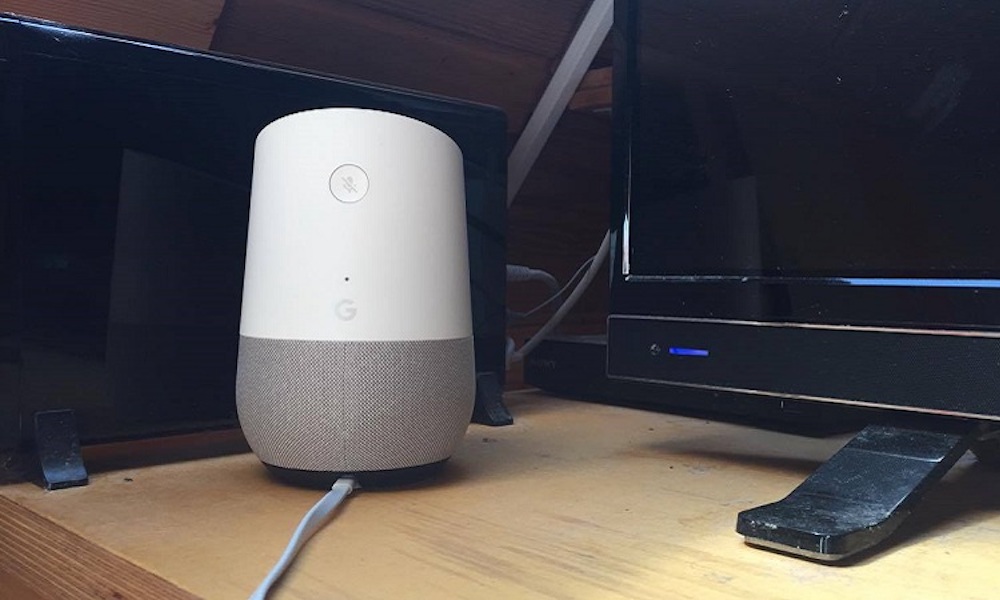For a week, Google Home has been in my apartment. The smart speaker is now firmly integrated into my life and has helped to make my home more connected. Nevertheless, the technology is still in its early stages. It’s time to draw a conclusion.
Although Google Home has only been in my apartment for a week, it has already changed location three times. From a glass table to a place on a wooden shelf to its present location, the place next to the TV, the smart speaker has moved a few times.
Regardless of its environment, the gadget has always suited its environment. Simple in appearance and pleasantly unobtrusive, the smart home device can be placed almost anywhere. The only prerequisite is a socket in the vicinity, because without electricity, Home won’t work.
Setup and data protection
For me personally, setting up Google Home was a big step. Basically, I take care of my data and prefer to avoid giving it out too much.
What I noticed when installing the device is that if you don’t share your data, Google Home is nothing more than a loudspeaker for music.
In order to use the other functions of Home, you must give Google access to your location and Wifi as well as grant access to data such as search history, browsing history, app activities, etc. You must connect your Google account to the device to use Google Home.
If you are not willing to do this, you won’t be able to use the speak function of Home, since voice input doesn’t work without complete access to your data. This also applies, for example, if one attempts to withdraw individual authorizations.
Conversations and artificial intelligence
Since testing a device without testing all its functionalities would be meaningless, I have declared myself ready to provide the necessary information to the Google gadget.
For this, after a little more than an hour of setup, I get a digital companion – Google Assistant. The voice of Google Assistant is friendly, but its language skills are still developing. What I already noticed in my first conversations with it, I have confirmed over the next few days.
Google Home and Google Assistant understand instructions very well and implement them reliably. However, it becomes problematic as soon as you deviate from the standard phrases. (The standard phrases and how to say them are listed in the app).
If you say “Ok, Google, I would like to hear Taylor Swift,” it will answer: “Sorry, I can not help you yet.” However, If you say the standard phrase, “Ok Google, play Taylor Swift,” you’ll hear the desired music.
This makes it clear that the first German-language version of Google Assistant is relying not so much on artificial intelligence as on a phrase book. The programmers have stored a lexicon of questions and answers which is called up in response to the corresponding key phrase. The key phrase is “Ok Google” – or alternatively, “Hi Google.”
In order to not miss a command, Google Home constantly listens to its environment. To escape this eavesdropping, you can manually mute the microphones using a button on the device.
Features and compatibility
To start music (Spotify, Google Play Music, Deezer all in the premium version) or series (including Netflix and Google Chromecast) via Google Home, the corresponding accounts must also be linked to your Google account and the voice recognition of Google Home.
Google Home is able to dim the lights using smart lamps from Philips Hue, and its music playing abilities are relatively reliable. Even with loud ambient noise, Google recognizes my voice. The instructions are implemented – as long as I choose the right words.
Things are more problematic when it comes to accessing third-party services. As an iPhone user, I manage my daily routine via Apple’s calendar app. I only use the Google Calendar professionally. If I want to know what is on my private schedule for the week, Google Home can’t help. That’s too bad.
In addition, the device seems to get confused when there are several speakers. After some of my friends had talked to my Google Home for a while, the device was slower at responding to my voice.
Conclusion: Interesting gadget with room to grow
All in all, my conclusion about Google’s smart speaker is that it still has room to improve. Google Home has surprised me some, and has simplified some processes such as searching for music or checking the weather forecast.
However, the smart-home skills could definitely be improved. If I want to dim my lamps in the living room, Home only offers a small repertoire of colors and options. With the Philips app, I can change the light faster and have more options.
The same is true for Spotify. Playlists are only played from the beginning. With Home, it’s not possible to replay a song or start from a certain part of the playlist. This means I always hear only the first songs of my Playlist of more than 500 songs. Unless I pass the home speaker over my smartphone the appropriate start.
The range of functions and level of language comprehension are both at a very basic level. I would have expected more flexibility. These issues will, however, hopefully be solved in future updates.
All in all, Google Home is currently more of a smart speaker than a personal assistant. Personally, I’m also bothered by the fact that the device needs access to so much data.
This is why I can’t currently say whether I will keep using Home and Assistant in the coming weeks. However, one thing is clear: Google Home will never find a home in the household of a privacy nut.










